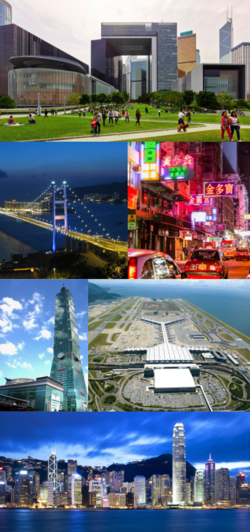Kwun San
Kwun San
觀山 | |
|---|---|
| Kwun San Capital Area | |
 Clockwise from top: Legislative Council Complex, Kungwo Street at night, Kwun San International Airport, Kwun San skyline from Cheungpo Harbour, Kwun San 111, Kwun San Cross-Harbour Bridge | |
| Country | |
| Region | Kwun San Capital Area |
| Government | |
| • Mayor | Leung Suk-yee (NPP) |
| Area | |
| • City | 1,981 km2 (765 sq mi) |
| • Metro | 18,209 km2 (7,031 sq mi) |
| Population | |
| • City | 11,428,800 |
| • Density | 5,769.2/km2 (14,942/sq mi) |
| • Metro | 19,791,300 |
| Time zone | +6 |
Kwun San (Tungwanese: 觀山), officially known as the Kwun San Capital Area, is the capital and primate city of Tung Wan. It is the seat of the national government, and is the center of the country's economic activity. As of the 2020 census, it reported a population of 11.4 million people, making it the most populous city on the continent of Erimia. Combined with the cities of Tin Wan and Hui Po, Kwun San forms the heart of the Greater Kwun San area, a metropolitan area with a population of 19.8 million people. The city is located on the shore of Cheungpo Harbour, on the central coast of Tung Wan's primary island, Lai Hoi Island. To the north of the city lies Kwun San Lake, and further north, Mount Tin Kung.
The city has always been prominent within the Tungwanese domain due to its advantageous strategical position on the banks of the freshwater Kwun San Lake, and Cheungpo Harbour, making it the primary trading center of the Tungwanese civilization for over five thousand years. Control of the city has historically led to command over Tung Wan as a whole, cemented by the construction of Mopo Palace, the center of imperial power since the fourth century. Consistent growth and economic development led to Kwun San becoming one of the most populous cities in the world with a population of over one million people by the turn of the 18th century. The foundation of the Republic of Tung Wan, and the introduction of a capitalist system in the country led to rapid development and modernization of the city throughout the 1960s to the 1980s, with Kwun San spearheading the Tungwanese Economic Miracle.
Today, Kwun San is considered to be a global city due to its international importance as a trading and financial hub, and is the world's second-largest metropolitan economy by gross domestic product. Kwun San is home to over sixty of the world's 500 largest companies. The city is also a manufacturing and industrial hub for Tung Wan's burgeoning consumer electronics industry, forming the country's so-called Silicon Belt alongside the southern coastal cities of Tin Wan, Ping Chung, and Tsim Kap Mei. In 2020, the city ranked as the world's third-most competitive financial center. Kwun San's highly-developed infrastructure places it near the top of many international livability rankings, with Kwun San coming third in the world in 2021. Kwun San Central Station is the busiest train station in the world, and links the city to the rest of Lai Hoi Island via the Tsuksin high-speed rail system. Kwun San International Airport, the world's busiest cargo airport and third-busiest passenger airport, is located on an artificial island in Cheungpo Harbour.
Kwun San's skyline includes numerous notable architectural projects, such as the Kwun San 111, Morningstar Tower, Hoisin Tower, and IFC One, as well as internationally-recognized historical sites including the Royal Mausoleum of the Choi Dynasty, Chungwu Floating Shrine, and Yuen Kwok Fortress. Kwun San is the birthplace of modern Tungpop and the Tungwanese Wave, owing to the fact that many of Tung Wan's major broadcasters and entertainment conglomerates are headquartered there. Notable recording studios and film production companies, such as the world-renowned Keung Family Studio.
